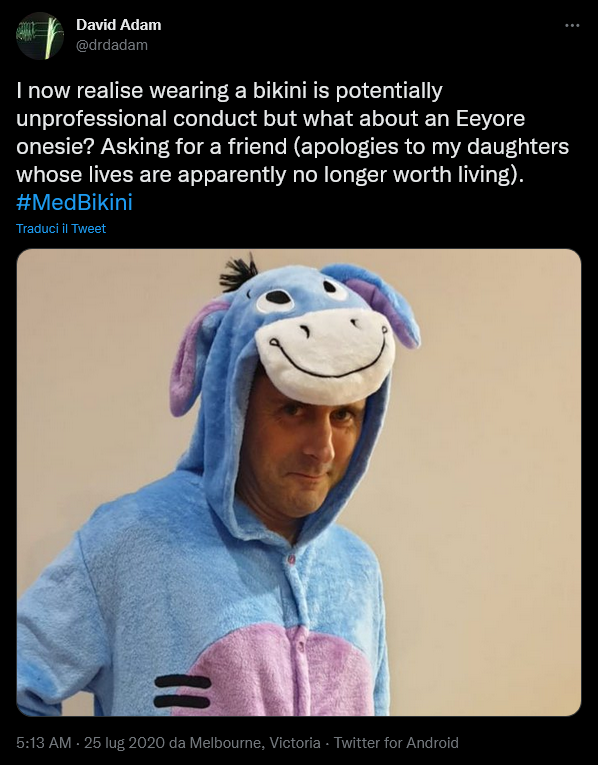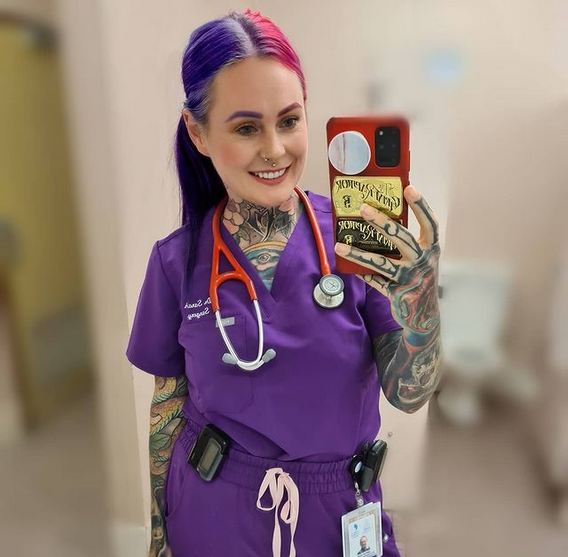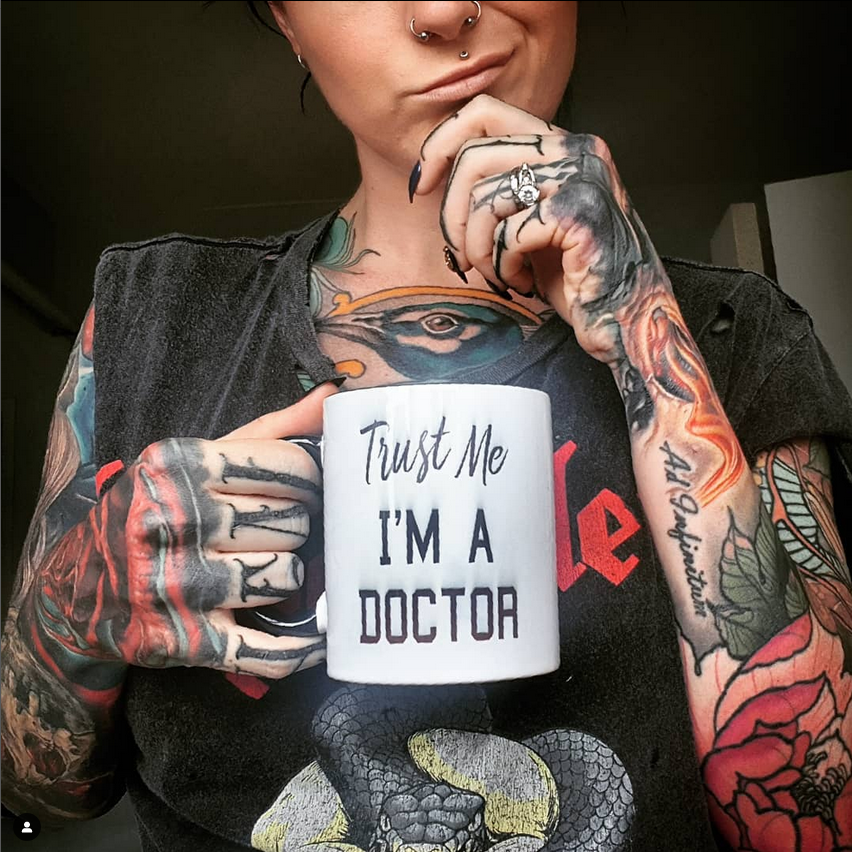"Doctors with messy beards, in tank tops, with too obvious piercings, not combed. Many were proposing an image that was undignified and not in line with medical ethics, which stipulates a precise habitus in the code of ethics. So I launched a provocation to give a precise signal, since those photos end up on the medical ID badge I had the question on whether to include indications on how physicians should dress for the badge photo: jacket and tie recommended. Ultimately, I ask that all members of the Order of Physicians look clean and respectable: a well-groomed face with tidy hair and appropriate hairstyles, since this is an official and very important document. On the other hand, standards are also required for other titles of identification and the same respect must apply to the Order's badge'."
"In this profession, image is also substance. The first impression a patient has when you present yourself is fundamental. All the more so in a society where image is so central. After all, the concept of professional decorum is also in the Hippocratic oath'."
"Public social profiles in which physicians post holiday photos and appear in swimsuits: this is also wrong. A physician always is, even when not on duty. Everything he does, says or posts must be consonant with the profession he represents. To see a physician in inappropriate attire is unbecoming and deeply disappointing to the potential patient. Another problem is selfies in the ward: you may not think about it, but behind a photo taken in the ward there are many implications".
"They will tell me that I am an old-fashioned person, but I will proceed with this as long as I am president".
Italy: "Doctor, what are you wearing?!"
A statement by an Italian physician association president on "indecorous" physicians’ photos, opens a wider debate on professional decorum and dignity.
Crisarà's statement
In recent days, statements by Dr. Domenico Maria Crisarà, born in 1961, current President of the Order of Physicians of Padua, a city in northern Italy, have caused much discussion.
Read Dr Domenico Crisarà's statements, translated from the original Italian version, here1
The case arose because Dr Crisarà allegedly decided not to accept applications for membership of the Padua Medical Association accompanied by unseemly passport photos. In statements reported by various press offices, Dr Crisarà sketches out the canons that define "decent" passport photos for the medical card and then addresses the issue of the images disseminated by physicians on their social media accounts, both those concerning their private lives and those taken at work: for example on the hospital ward.
You are still a physician, even when you take your gown off
The first issue we focus on, central to the debate on social media, is that of the scope of the deontological dictates. Many physicians have commented on Dr Crisarà's words, pointing out that what one does outside the workplace is not the business of the Medical Association, as long as one remains within the limits imposed by law. In reality, this is not the case in Italy. According to the Code of Medical Deontology, every physician must conduct themselves so as not to harm the decorum and dignity of the profession even outside working hours.
Even the Italian courts, which have had to deal with legal disputes between medical associations and their members, have reiterated the notion that professional medical ethics goes beyond the ward or outpatient clinic.
There is not much to add to this: if you are a physician, you are always a physician, even when you are at a restaurant with friends or on holiday with your partner or spouse. Even on those occasions, you answer to your colleagues for your actions, if they can damage the profession.
Decorum and dignity
The second major element of the discussion: decorum and dignity of the profession must be protected. But what is meant by decorum and dignity of the profession? Which acts are decent, which are not? Which acts enhance or detract from the dignity of the medical community?
Credit: Dr. David Adam. Twitter: @drdadam
This field is undoubtedly complex. The Italian code of ethics does not go into it, and it does not give definitions, staying in a vague and general tone. Probably with good reason. Subjective ethical and moral perceptions, objective elements and common sense, social, cultural and economic contexts, experiences and contingencies should determine, from case to case, what is more or less decent and dignified for the medical profession. Since there is no definition of decorum and dignity in the code of ethics, it is therefore the medical community that must question itself, when the need arises, on the individual case, on the individual event, with the primary objective in our view of establishing in a collegial manner not only what is decent or dignified, but what can cause concrete harm to the medical profession.
In our view, the concept of damage done to the profession is more tangible, a parameter that one can even try to measure - a fundamental element for those who are scientists. Professional deontology, recognised inside and outside the professional association, reinforces technical competence, giving authority to individual professionals. Those who damage the authority of all, the work of all, offend the decorum and dignity of the profession, we could simplify.
Dr Cassarà addresses the issue of professional decorum and dignity by talking about ID card photographs. He calls for a jacket and tie to be worn as required for the passport photo. Are we therefore to think that anyone who takes a photo in a T-shirt, which Crisarà believes is not decorous, is harming the profession? Can this harm also other colleagues and more or less their standing with patients? Can unshaven beards, messy hair, piercings, tattoos, cause harm? What harm and to whom? Are physicians less capable if they have not had time to go to the hairdresser?
The question of the photos of the Medical Association membership card seems to us to trivialise the issue. On the new badges adopted by most provincial orders, the photos are tiny frames of a few pixels that barely allow one to distinguish the face. That photo serves to identify the person, it has no other purpose or function.
Dr Sarah Jane Gray, an orthopaedic surgeon living in Adelaide, Australia, is considered the most tattooed physician in the world. Credit: Dr. Sarah Jane Gray, Instagram: @rosesarered_23
Does the suit make the physician?
The physician in a suit and tie, wearing a perfectly pressed white coat and trousers, greeting you in a surgery dominated by fine wooden furniture and medical books. This is the classic image of the physician recalled by Dr Crisarà, one of many possible in modern times. Today, there is also the female physician in yellow overalls and reflective bands, cap with visor, mountain backpack and heavy, hard-to-remove safety shoes at the end of her shift. Shall we add another image? The phyisician in green overalls, never the right size, tying a badly dangling string around his waist, autoclave-washed rubber slippers and brightly coloured cap. And again, on the seventh floor of the hospital we find physicians with red clown noses, colourful gowns and cartoon stickers in their pockets. One could go on and on describing the various images of physicians that now belong to the collective memory of our society. Which one is the right one? Which one is more valid in keeping up with the decorum and dignity of the profession? Where do we find indications of the physician's habitus? Who decides this?
According to the comments left by physicians and non-physicians on social networks after Dr Crisarà's statements, the right image is that of the competent and scrupulous physician. Few care whether you wear jeans or a smart suit, whether you have an unshaven beard or a 'clean' face, whether you wear flats or heels, whether you have one tattoo or ten. Most care about the substance (this topic should certainly be explored further, because comments left on social media were at times as good as a bar talk, but we felt that within this editorial, mentioning this trend was a helpful hint on where opinions point to on this issue).
Physicians' photos on social media
Knowledge, technical and methodological skills, scientific rigour, capacity for dialogue and confrontation, communication skills, transparency and honesty are some of the characteristics that make up the substance of the good doctor in our opinion. However, the relationship between form and substance in the modern era cannot be dichotomous, especially since image is the calling card with which one presents oneself to the patient, a patient with whom one must establish one of the most delicate relationships, the care relationship, which is also a relationship of trust.
In the era in which we live, where most of us, physicians included, have at least one active social account through which we share images, videos, or personal opinions, it may make sense to ask ourselves how we can use these very powerful communication tools without harming the decorum and dignity of the profession. But, we repeat once again, we must not trivialise the issue. Should we really think that today a patient would be disappointed to see their physician in a swimsuit at the beach?
Credit: Dr. Erek Latzka, Twitter: @ErekLatzkaMD
Photos on social media of physicians on holiday, says Dr Crisarà, can damage the decorum and dignity of the profession. Does the medical community today believe that posting holiday photos of physicians in swimsuits is detrimental to the medical profession? If so, to what extent? What impact does taking selfies on the ward have on the decorum and dignity of the profession? How many and what are the elements to be considered to define an indecorous selfie? Does a physician lose dignity (and cause also colleagues to lose theirs) if they post a picture on social media of themselves in a skimpy dress at a party? Is a physician indecent if they post a photo on social media of a tender moment with their partner?
What are the boundaries beyond which a physician in their private life can violate the decorum of the profession? The topic is an important one. One only has to do a search on PubMed to find dozens of studies on the psychology of dress in the medical field and the use of social media by physicians. Some research has caused a stir, such as the one that led the Journal of Vascular Surgery to retract its article 'Prevalence of unprofessional social media content among young vascular surgeons' two years ago, which called some posts by physicians, especially female professionals, as 'potentially unprofessional'. The article specifically mentioned photos that included 'provocative poses in bikinis/swimwear' and 'possession/consumption of alcohol'. The article was withdrawn and the magazine publicly apologised after outraged physicians flooded Twitter with photos of themselves posing in bikinis and holding alcoholic beverages. The hashtag #Medbikini went viral in a very short time.
Credit: Dr. Danielle Belardo, Twitter: @DBelardoMD
The use of social networks by physicians is undoubtedly a subject that deserves attention, study and discussion, right from medical school in university. What we have seen and read on social media during the last two years of the pandemic demonstrate the irrefutable need to provide physicians with professional and shared communication approaches, and to stop considering communication with the patient and the community an unnecessary personal attitude.
The scale of priorities
Dr. Crisarà seems determined to fight by any means what he considers to be detrimental to the decorum and dignity of the medical profession, i.e. the passport photos that portray new graduates with unkempt or dishevelled beards and the photos of physicians on holiday, who are wearing swimsuits on the beach.
We, in all sincerity, hope that the statements made by Dr Crisarà only have a provocative value in order to turn our attention to the relevant issue of the protection of the decorum and dignity of the medical profession in modern times, including through social media.
We believe it is essential to ask questions and discuss within the local and international medical community; and it is unacceptable for anyone to impose their vision convinced that they already have the answers in their pocket. Through discussion and the exchange of opinions, perhaps we can come to the conclusion that those who contribute to the circulation of fake news are more damaging to decorum than those who do not shave their beards, that the physician who does not adhere to the principles of the scientific community is more deserving of attention than those who wear scrubs over a T-shirt and a pair of jeans, that we must strive to identify the dishonest physician who does business by wallowing in conflicts of interest, instead of worrying about the physician covered in tattoos, and that we must fight the macho culture that often hinders female physicians' access to leadership roles much more than focusing on photos in swimming suits taken at the beach.
Credit: Dr. Sarah Jane Gray, Instagram: @rosesarered_23
- The reported statements were sent to esanum by the press office of the Provincial Order of Surgeons and Dentists of Padua (In Italian: Ordine Provinciale dei Medici Chirurghi e degli Odontoiatri di Padova).
- To learn more about the #Medbikini topic, please read Medium's article What You Need to Know About the Infamous #MedBikini Study by Caitlin Laughney.
- This article was translated from the original Italian version.




